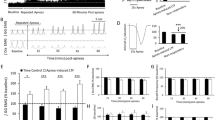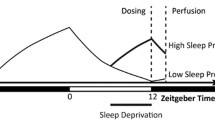Abstract
We reported previously that activation of vagal feedback by protoveratrines or serotonin exacerbates sleep apnea in rats, but each of these agents activates multiple afferent fiber types. To elucidate the specific impact of C-fiber activity on sleep apnea, the present study utilized capsaicin (CAP), which stimulates C-fibers via the CAP receptor. Nine adult Sprague-Dawley rats were instrumented for chronic polysomnography and recorded for 6 hours on four occasions. Prior to each recording, the animals received an intraperitonea injection of either saline (control), or CAP 0.1, 1.0, or 10.0 mg/kg. Respiration was monitored by single-chamber plethysmography and apneas were scored as breaths longer than 2.5 seconds not preceded by a sigh. CAP increased apneas during non-rapid eye movement (NREM) sleep (p< 0.05 vs control) and reduced respiratory minute ventilation by about 15% in all behavioral states (waking, NREM, and REM sleep). We conclude that selective pharmacological activation of C-fibers produces a diathesis of sleep-disordered breathing specific to NREM sleep in rats.
Similar content being viewed by others
References
Jacobs L, Comroe J H Jr. Reflex apnea, bradycardia, and hypotension produced by serotonin in cats. Circ Res 1971;29:145–155
Clozel JP, Pisarri TE, Coleridge HM, Coleridge JC. Reflex coronary vasodilatation evoked by chemical stimulation of cardiac afferent vagal C fibers in dogs. J Physiol 1990;428:215–232
Paintal AS. Impulses in vagal afferent fibers from specific pulmonary deflation receptors. The response of these receptors to phenyl diguanide, potato starch, 5-hydroxytryptamine and nicotine and their role in respiratory and cardiovascular reflexes. Q J Exp Physiol 1955;40:348–363
Coleridge HM, Coleridge JCG, Kidd C. Role of pulmonary arterial baroreceptors in effects produced by capsaicin in the dog. J Physiol 1964;170:272–285
Hedner J, Hedner T, Jonason J. Capsaicin and regulation of respiration: interaction with central substance P mechanisms. J Neural Transm 1985;61:239–252
Trbovic SM, Radulovacki M, Carley DW. Protoveratrines A and B increase sleep apnea index in Sprague-Dawley rats. J Appl Physiol 1997;83:1602–1606
Carley DW, Radulovacki M. Role of peripheral serotonin in the regulation of central apneas in rats. Chest 1999;115:1397–1401
Radulovacki M, Trbovic SM, Carley DW. Serotonin 5-HT3-receptor antagonist GR38032F suppresses sleep apnea in rats. Sleep 1998;21:131–136
Veasey SC, Chachkes J, Fenik P, Hendricks JC. The effects of ondansetron on sleep-disordered breathing in the English bulldog. Sleep 2001;24:155–160
Carstens E, Klumpp D, Randic M, Zimmermann M. Effect of iontophoretically applied 5-hydroxytryptamine on the excitability of single primary C- and A-fibers in the cat spinal cord. Brain Res 1981;220:151–158
Holzer P. Capsaicin: cellular targets, mechanism of action, and selectivity for thin sensory neurons. Pharmacol Rev 1991;43:203–242
Diaz V, Arsenault J, Praud J-P. Consequences of capsaicin treatment on pulmonary vagal reflexes and chemoreceptor activity in lambs. J Appl Physiol 2000;89:1709–1718
Bennington J, Kodali S, Heller C. Scoring transitions to REM sleep in rats based on the EEG phenomena of pre-REM sleep: an improved analysis of sleep structure. Sleep 1994;17:28–36
Carley DW, Radulovacki M. Mirtazapine, a mixed-profile serotonin agonist/antagonist, suppresses sleep apnea in the rat. Am J Respir Crit Care Med 1999;160:1824–1829
Carley DW, Trbovic S, Radulovacki M. Hydralazine reduces elevated sleep apnea index in spontaneously hypertensive (SHR) rats to equivalence with normotensive Wistar-Kyoto rats. Sleep 1996;19:363–366
Christon J, Carley DW, Monti D, Radulovacki M. Effects of inspired gas on sleep-related apneas in rats. J Appl Physiol 1996;80:2102–2107
Monti D, Carley DW, Radulovacki M. Adenosine analogs modulate the incidence of sleep apneas in rats. Pharmacol Biochem Behav 1995;51:125–131
Anand A. Influence of bronchial C fibre receptors on respiration in cats: possible role in humans. Respir Physiol 2000;123:1–12
Ravi K, Dev NB. Metoclopramide blocks the phenyl diguanide and 5-hydroxytryptamine induced cardiorespiratory reflexes in cats and dogs. Can J Physiol Pharmacol 1988;66:776–782
Saria A, Skofitsch G, Lembeck F. Distribution of capsaicin in rat tissues after systemic administration. J Pharm Pharmacol 1982;34:273–275
Author information
Authors and Affiliations
Corresponding author
Rights and permissions
About this article
Cite this article
Carley, D.W., Pavlovic, S., Malis, M. et al. C-Fiber Activation Exacerbates Sleep-Disordered Breathing in Rats. Sleep Breath 8, 147–154 (2004). https://doi.org/10.1007/s11325-004-0147-7
Issue Date:
DOI: https://doi.org/10.1007/s11325-004-0147-7




